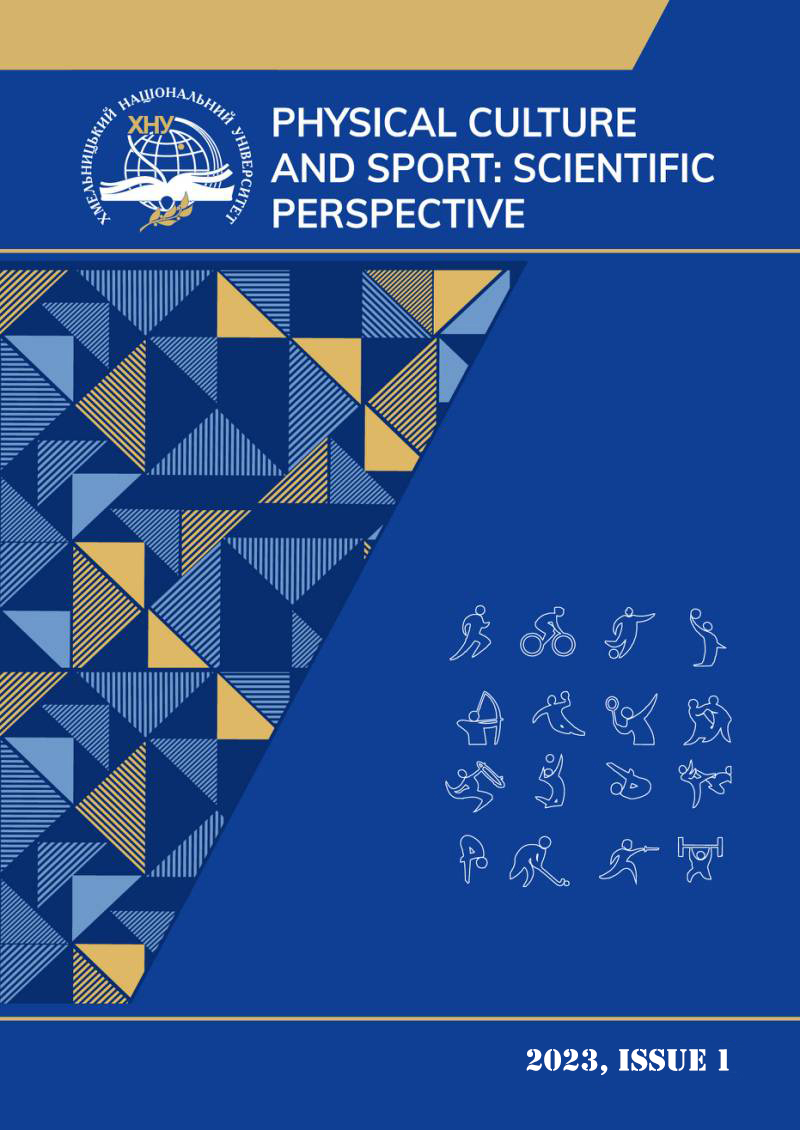DEFINITIONS OF PHYSICAL RECREATION AND PROBLEMS OF PHYSICAL AND SPORTS ACTIVITIES
DOI:
https://doi.org/10.31891/pcs.2023.1.6Keywords:
physical recreation, health, load, vital activity, recreational activities contentAbstract
An analysis of the definition of the concept of "physical recreation" was carried out. The limits of the use of the studied concept and the main features that reflect it have been established. The content aspect of physical recreation, which is recommended for its implementation, has been studied. The inconsistency of the used means with the main definitive signs was revealed. The main risks for health during the use of inadequate means of physical recreation are noted.
The problem of the research is that there are excessive ideas about the content of physical recreation, which makes it difficult to achieve its main goal - the restoration of the vital forces of any person.
In order to achieve the goal of this study, the scientific works of Ukrainian scientists dealing with the problems of physical recreation and foreign specialists in the field of health-related physical culture were studied.
In order to achieve the goal of this study, the scientific works of Ukrainian scientists dealing with the problems of physical recreation and foreign specialists in the field of health-related physical culture were studied. With the help of contextual analysis, the main features and target settings that determine the content of recreational activities are highlighted.
The results of the analysis of the definition of the concept of "physical recreation" and the problems that arise due to the ambiguity of its interpretation when choosing the content of recreational activities are given. It is noted that the increasing tension of modern life simultaneously increases the level of the total load that a person receives in the course of daily life, and worsens his health. Scientists have researched that it is physical recreation that ensures the restoration of the body's vital forces and their support in the process of daily life. The factors of inclusion in the content of recreational forms of classes of various types of physical exercises are defined and substantiated.
References
Visitіі M. M. Physical culture and health of the athlete (philosophical anthropological aspect of the problem). Theory and practice of physical culture. - 2008. No. 2. P. 3-8.
Dubogai O.D. Basic concepts and terms of health care and physical rehabilitation in the education system: teaching. manual for students of higher education closing Lutsk: Volyn. National University named after Lesya Ukrainka. 2011. P. 275-279.
Dutsiak I. Types of definitions according to the content of information about the relationship between the volumes of the defined and related concepts // Visnyk Nats. Lviv Polytechnic University. Series "Problems of Ukrainian Terminology". 2017. No. 869. P. 35–39.
Kalynychenko, I.O., Zaikina, G.L., Antomonov, M.Yu. Assessment of the individual psychophysiological "cost" of mental workload: Scientific and methodological edition. Sumy: Sumy DPU named after A. S. Makarenko. 2007. 14 p.
Krutsevich T. Yu. Recreation in the physical culture of different population groups: education. manual Kyiv: Olymp. literature, 2010. 370 p.
Krutsevich T. Yu. Theory and methods of physical education: tutorial. For students higher education closing physical education and sports: in 2 vols. Kyiv.: Olympic literature, 2008. Vol. 1,391 p.; T. 2. 366 p.
Kuchkovskiy O.M. Peculiarities of heart rate indicators in first- and second-year students at the beginning of the academic year // Current issues of modern medicine and pharmacy: coll. theses add. science and practice conf. from international with the participation of young scientists and students, May 13-17. 2019. Zaporizhzhia: ZDMU, 2019. P. 13-14.
Patsalyuk K. G. Programming of strength-oriented physical education and health classes for young men // K. G. Patsalyuk, D. R. Kovalchuk, O. O. Kovtun: Scientific and pedagogical problems of physical culture (physical culture and sport): coll. of science works Kyiv, 2019. P. 123-127.
Plotnykova O. The importance of studying the individual characteristics of first-year students in the period of didactic adaptation // Native school. 2001. No. 10. P. 62-64.
Smirnytska M.B. The results of the study of the impact of physical factors of the educational process on the health of students // Human occupational safety in modern conditions: materials of the International. science and practice conference. Kharkiv, 2015. P.148-150
Tomenko O.A. Level of somatic health and motor activity of students of higher educational institutions. Slobozhansky scientific and sports bulletin: science and theory. journal 2010. No. 2. P. 17–20.
Fedorchenko V. K. Tourist dictionary-handbook. Dnipro, 2000. 160 p.
Tsyos A. The program of independent physical exercise classes for students of higher education institutions // Physical education, sport and health culture in modern society: coll. of science Lutsk Ave., 2008. Vol. 2, pp. 271–275.
Yavorovska L.M. The problem of adaptation of first-year students to the process of studying at a university // All-Ukrainian scientific and practical conference "Actual problems of continuous education": Abstracts of reports. Kharkiv, 2003. P. 106-107.
Herold, F. Dose—Response Matters! — A Perspective on the Exercise Prescription in Ex- ercise—Cognition Research / F. Herold, P. Müller,T. Gronwald, N.G. Müller // Front Psychol. — 2019. —№ 10. — P. 2338.
Wasfy, M. Exercise Dose in Clinical Practice / M. Wasfy, A.L. Baggish // Circulation. — 2016. — Vol. 7, no. 133(23). — Р. 2297—2313.
Warburton, D.E.R. Health benefits of physical activity: a systematic review of current systematic reviews / D.E.R. Warburton, S.S.D. Bredin // Curr- OpinCardiol. — 2017. — № 32 (5). — Р. 541—556.





